Find more information in the General Comments section of the assessment
Find more information in the Rating Validity tab of the assessment
- See More
- See More
- See More
- See More
- Good
- Adequate
- Marginal
- Weak
- Poor
 Passenger
Passenger
 Driver
Driver
 Front Seat
Front Seat
 Car
Car
 Pole
Pole
- Good
- Adequate
- Marginal
- Weak
- Poor


Passenger
outboard
Fitted to the vehicle as standard
Not fitted to the test vehicle but available as option
Not Available
-
Infants up to 13 kg
-
Infants and toddlers up to 18 kg
-
Toddlers from 9 to 18 kg
-
Toddlers over 18 kg
Easy
Difficult
Safety critical
Not allowed
| Seat Position | ||||
|---|---|---|---|---|
| Front | 2nd row | |||
| Passenger | Left | center | Right | |
| Maxi Cosi Cabriofix (Belt) | ||||
| Römer King Plus (Belt) | ||||
| Römer Duo Plus (ISOFIX) | ||||
| Römer KidFix (Belt) | ||||
| Maxi Cosi Cabriofix & EasyFix (Belt) | ||||
| Maxi Cosi Cabriofix & EasyFix (ISOFIX) | ||||
| BeSafe iZi Kid X3 ISOfix (ISOFIX) | ||||
| Maxi Cosi Pearl & Familyfix (ISOFIX) | ||||
| Römer KidFix (ISOFIX) | ||||
Easy
Difficult
Safety critical
Not allowed
Based on dummy readings and measurements in the dynamic tests, the IS 300h scored maximum points for the protection it provided to both the 18 month and 3 year infants. In the frontal impact, forward movement of the head of the 3 year dummy, sat in a forward-facing restraint, was not excessive. In the side impact, both dummies were properly contained by the protective shells of their restraints, minimising the likelihood of dangerous head contact with the car interior. The front passenger airbag can be deactivated to allow a rearward-facing child restraint to be used in that seating position. Clear information is provided to the driver regarding the status of the airbag and the system was rewarded. All categories of child restraints for which the car is designed could be safely installed in the vehicle.
- Good
- Adequate
- Marginal
- Weak
- Poor

Head Impact 16.9 Pts
Pelvis Impact 6.0 Pts
Leg Impact 6.0 Pts
The IS 300h has an 'active' bonnet which provides additional head protection for struck pedestrians. Sensors in the bumper detect when a pedestrian has been struck and actuators lift the bonnet to provide greater clearance to the hard structures underneath. Lexus showed that the system could detect pedestrians of different statures over a range of speeds. Accordingly, the car was tested with the bonnet in the deployed position and provided good or adequate levels of protection over most of the bonnet surface. The bumper and the leading edge of the bonnet also performed well, the car scoring maximum points for the protection it offered to the legs and pelvis of a struck pedestrian.
- Good
- Adequate
- Marginal
- Weak
- Poor
| Speed Limitation Function | Manually Set |
| System Name | VSC | |
| Performance | ||
| Vehicle Yaw Rate @ COS + 1.00 s | 1.959% | meets ECE requirements |
| Vehicle Yaw Rate @ COS + 1.75 s | 1.648% | meets ECE requirements |
| Lateral Displacement @ BOS + 1.07 s | 3.17 m | meets ECE requirements |
| Applies To | All seats | ||
| Warning | Driver Seat | Front Passenger(s) | Rear Passenger(s) |
| Visual | |||
| Audible | |||
|
|||
--safetyAssistCommentEN--
- Specifications
- Safety Equipment
- Videos
- Rating Validity
Specifications
Tested Model Lexus IS 300h 2.5 Hybrid Drive, 'Executive Plus', RHD
Body Type - 4 door saloon
Year Of Publication 2013
Kerb Weight 1670kg
VIN From Which Rating Applies - applies to all IS 300h of the specification tested
Class Large Family Car
Safety Equipment
Note: Other equipment may be available on the vehicle but was not considered in the test year.
Fitted to the vehicle as standard
Fitted to the vehicle as option
Not fitted to the test vehicle but available as option
Not Available
Not Applicable
Videos
Rating Validity





Find more information in the General Comments section of the assessment
 Share
Share
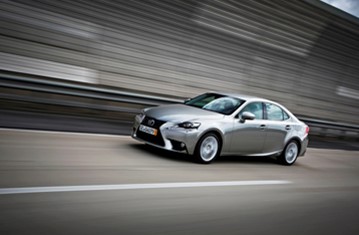
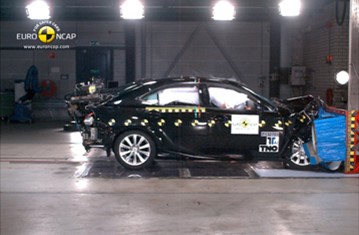
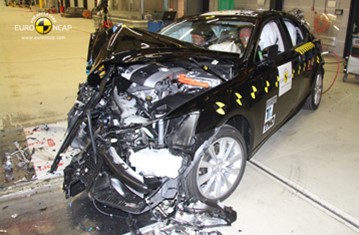
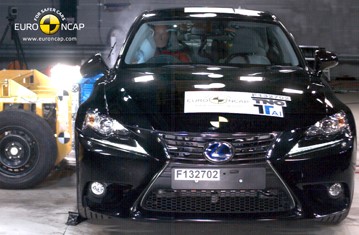
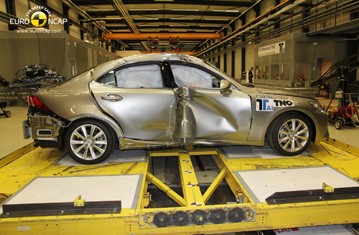
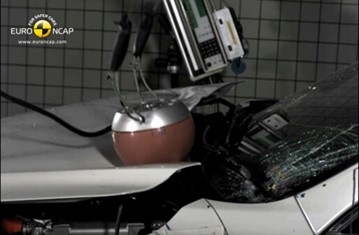




The passenger compartment of the IS 300h remained stable in the frontal impact. Dummy readings indicated good protection of the knees and femurs of both the front seat occupants. Lexus showed that a similar level of protection would be provided to occupants of different sizes and to those sat in different positions. The car scored maximum points in the side barrier test, providing good protection to all parts of the body. Even in the more severe side pole test, protection of the chest was adequate and that of other body regions was good. The seat and head restraint provided good protection against whiplash injuries in the event of a rear-end collision.